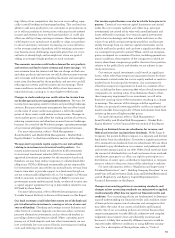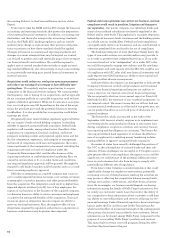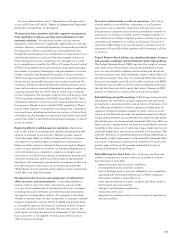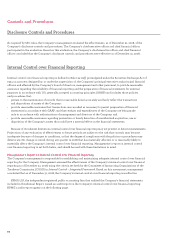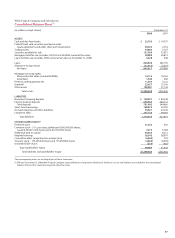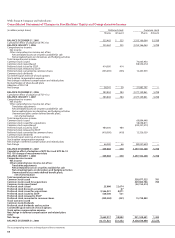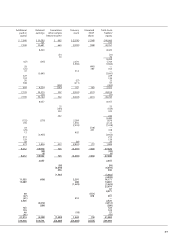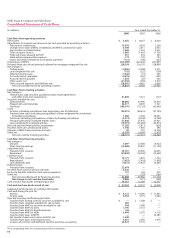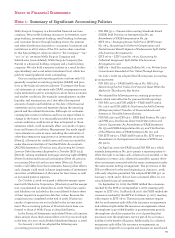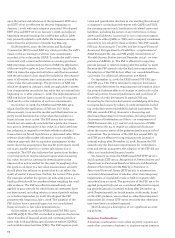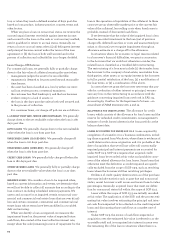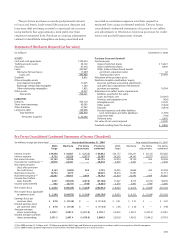Wells Fargo 2008 Annual Report Download - page 93
Download and view the complete annual report
Please find page 93 of the 2008 Wells Fargo annual report below. You can navigate through the pages in the report by either clicking on the pages listed below, or by using the keyword search tool below to find specific information within the annual report.
Notes to Financial Statements
Wells Fargo & Company is a diversified financial services
company. We provide banking, insurance, investments, mort-
gage banking, investment banking, retail banking, brokerage,
and consumer finance through banking stores, the internet
and other distribution channels to consumers, businesses and
institutions in all 50 states of the U.S. and in other countries.
In this Annual Report, when we refer to “the Company,” “we,”
“our” or “us” we mean Wells Fargo & Company and
Subsidiaries (consolidated). Wells Fargo & Company (the
Parent) is a financial holding company and a bank holding
company. We also hold a majority interest in a retail broker-
age subsidiary and a real estate investment trust, which has
publicly traded preferred stock outstanding.
Our accounting and reporting policies conform with U.S.
generally accepted accounting principles (GAAP) and prac-
tices in the financial services industry. To prepare the finan-
cial statements in conformity with GAAP, management must
make estimates based on assumptions about future economic
and market conditions (for example, unemployment, market
liquidity, real estate prices, etc.) that affect the reported
amounts of assets and liabilities at the date of the financial
statements and income and expenses during the reporting
period and the related disclosures. Although our estimates
contemplate current conditions and how we expect them to
change in the future, it is reasonably possible that in 2009
actual conditions could be worse than anticipated in those
estimates, which could materially affect our results of opera-
tions and financial condition. Management has made signifi-
cant estimates in several areas, including the evaluation of
other-than-temporary impairment on investment securities
(Note 5), allowance for credit losses and loans accounted for
under American Institute of Certified Public Accountants
(AICPA) Statement of Position 03-3, Accounting for Certain
Loans or Debt Securities Acquired in a Transfer (SOP 03-3)
(Note 6), valuing residential mortgage servicing rights (MSRs)
(Notes 8 and 9) and financial instruments (Note 17), pension
accounting (Note 20) and income taxes (Note 21). Actual
results could differ from those estimates. Among other effects,
such changes could result in future impairments of investment
securities, establishment of allowance for loan losses, as well
as increased pension expense.
On October 3, 2008, we signed a definitive merger agree-
ment with Wachovia Corporation (Wachovia) and the merger
was consummated on December 31, 2008. Wachovia’s assets
and liabilities are included in the consolidated balance sheet
at their respective acquisition date fair values. Because the
acquisition was completed at the end of 2008, Wachovia’s
results of operations are not included in the income state-
ment. The accounting policies of Wachovia have been con-
formed to those of Wells Fargo as described herein.
In the Financial Statements and related Notes, all common
share and per share disclosures reflect a two-for-one stock split
in the form of a 100% stock dividend distributed August 11, 2006.
On January 1, 2008, we adopted the following new
accounting pronouncements:
• FSP FIN 39-1 – Financial Accounting Standards Board
(FASB) Staff Position on Interpretation No. 39,
Amendment of FASB Interpretation No. 39;
• EITF 06-4 – Emerging Issues Task Force (EITF) Issue
No. 06-4, Accounting for Deferred Compensation and
Postretirement Benefit Aspects of Endorsement Split-Dollar
Life Insurance Arrangements;
• EITF 06-10 – EITF Issue No. 06-10, Accounting for
Collateral Assignment Split-Dollar Life Insurance
Arrangements; and
• SAB 109 – Staff Accounting Bulletin No. 109, Written Loan
Commitments Recorded at Fair Value Through Earnings.
On July 1, 2008, we adopted the following new accounting
pronouncement:
• FSP FAS 157-3 – FASB Staff Position No. FAS 157-3,
Determining the Fair Value of a Financial Asset When the
Market for That Asset Is Not Active.
We adopted the following new accounting pronounce-
ments, which were effective for year-end 2008 reporting:
• FSP FAS 140-4 and FIN 46(R)-8 – FASB Staff Position
No. 140-4 and FIN 46(R)-8, Disclosures by Public Entities
(Enterprises) about Transfers of Financial Assets and
Interests in Variable Interest Entities;
• FSP FAS 133-1 and FIN 45-4 – FASB Staff Position No. 133-1
and FIN 45-4, Disclosures about Credit Derivatives and
Certain Guarantees: An Amendment of FASB Statement
No. 133 and FASB Interpretation No. 45; and Clarification
of the Effective Date of FASB Statement No. 161; and
• FSP EITF 99-20-1, FASB Staff Position No. EITF 99-20-1,
Amendments to the Impairment Guidance of EITF Issue
No. 99-20.
On April 30, 2007, the FASB issued FSP FIN 39-1, which
amends Interpretation No. 39 to permit a reporting entity to
offset the right to reclaim cash collateral (a receivable), or the
obligation to return cash collateral (a payable), against deriv-
ative instruments executed with the same counterparty under
the same master netting arrangement. The provisions of this
FSP are effective for the year beginning on January 1, 2008,
with early adoption permitted. We adopted FSP FIN 39-1 on
January 1, 2008, and it did not have a material effect on our
consolidated financial statements.
On September 20, 2006, the FASB ratified the consensus
reached by the EITF at its September 7, 2006, meeting with
respect to EITF 06-4. On March 28, 2007, the FASB ratified the
consensus reached by the EITF at its March 15, 2007, meeting
with respect to EITF 06-10. These pronouncements require
that for endorsement split-dollar life insurance arrangements
and collateral split-dollar life insurance arrangements where
the employee is provided benefits in postretirement periods,
the employer should recognize the cost of providing that
insurance over the employee’s service period by accruing a
liability for the benefit obligation. Additionally, for collateral
assignment split-dollar life insurance arrangements, an
employer is required to recognize and measure an asset based
Note 1: Summary of Significant Accounting Policies


